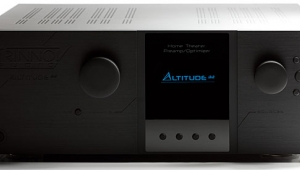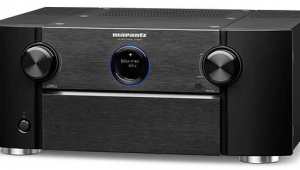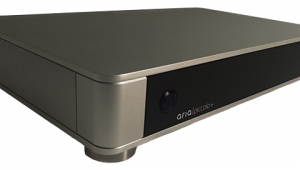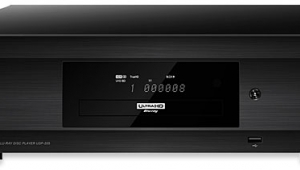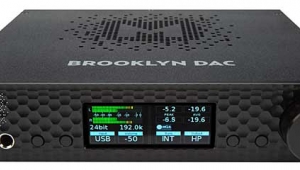| Columns Retired Columns & Blogs |
Music in the Round #44 Page 2
Why do I prefer HDMI to the analog configuration? First, because the issues of level, delay, and bass management just go away with the transmission of digital signals to the processor, and decent preamp-processors offer many options not seen in disc players, such as multiple outputs and configurations for subwoofers (see my report on Krell's Evolution 707 Reference surround-sound pre-pro below). Second, because a single HDMI cable is neater and simpler. I have closets full of unemployed interconnects.
Footnote 1: Krell Industries, LLC, 45 Connair Road, Orange, CT 06477-3650. Tel: (203) 799-9954. Fax: (203) 799-9796. Web: www.krellonline.com.
But if all is done right, there is nothing the analog interconnection scheme can do that the digital one can't do equally well. The converse is not true. The difference is digital room/speaker equalization in any one of its many guises, which is dependent on having access to the digital audio data. Great-sounding rooms can be designed and built without resorting to electronic EQ. However, the vast majority of audiophiles have little choice about which room their systems occupy; they can only make the best of it, including attention paid to furnishings, setup, and room treatment. At low frequencies, however, the room's dimensions place constraints on speaker positioning that, in my experience, almost always conflict with the ideal positions for imaging and soundstaging, and/or the demands of those with whom the space is shared. Moreover, as the frequencies of concern get lower, the physical size of the most effective acoustical treatments increases, which makes them increasingly impractical.
Correcting room modes with electronic equalization may not be the best solution, but it's often the most practical, and lessens the constraints on speaker and listener positioning. It reduces acoustical hangover, resulting in cleaner but more impactful bass. Since implementing room EQ in both of my systems, I have found it hard to tolerate non-EQ'd systems, particularly in untreated rooms: Too much nonmusical sound cloaks and clogs the music. Of course, you can add to an analog-connected system an external EQ, such as the Audyssey Sound Equalizer, but then you contravene the purist philosophy by inserting additional A/D/A conversions.
So choose wisely. Analog with decoding/processing in the player? Digital (HDMI) with decoding/processing in the processor? The former integrates nicely into an otherwise analog system, but the latter is more capable and can accommodate an analog preamp with an HT bypass for the front channels and stereo sources. Name your poison.
Krell Evolution 707 Reference surround-sound preamp-processor
How the Krell (footnote 1) got here: First, Krell announced that they'd added Automatic Setup/EQ to their flagship Evolution 707 Reference Processor ($30,000). Second, I've always admired the reputation and aggressive design of Krell products, but had never actually had one in one of my systems. They had me at "EQ."

After a few e-mails and phone calls, Bill McKiegan, Krell's director of global sales and marketing, agreed to drive over to my house in Connecticut and help me with a setup of the Evolution 707. I'm grateful; it would have been impossible for me to schlep the 56-lb processor from Manhattan and hoist it up onto my equipment rack by myself. The 707's height of 8.75" necessitated the removal of a shelf, that shelf then used to accommodate the pre-pro's 21.22" depth. This was important—the 707 generates a lot of heat, even in standby. In fact, it's the first component I felt I needed to completely unplug if I wasn't going to be using it for even a few days. Permanent installation of an Evolution 707 should be in a remote equipment closet with cooling. This is a serious device.
The 707's expansive front panel is dominated by a central dimpled knob for volume control. At the upper left is an easily read display window, and below that are four programmable operation buttons, 10 input selection buttons, a zone selector, a Power/Standby button, an IR window, and a jack for the calibration microphone. On the right are 15 buttons for mode selection, speaker adjustment, menu selection and navigation, mute, and memory save/recall. This may sound like a lot of buttons, but they're tiny, and the panel has lots of real estate.
As with any modern electronic device, all operations are more comfortably accomplished from the listening position with the remote control and OSD. Two minor caveats: First, the remote control is not backlit, making it difficult to use (or find) in a darkened room. Second, navigating the menu relies primarily on the Up/Down and Enter buttons; little use is made of the Left/Right buttons. A consequence of this arrangement is that more button pushes are required than if the L/R buttons had been employed. Still, this is of concern only during setup, and one quickly learns the skill.
The rear panel fairly bristles with connectors of all varieties: audio, video, control, programming, and power. In addition to any that you may have thought of, there are also two stereo Current Audio Signal Transmission (CAST, a proprietary Krell technology); the 12 output channels are available via single-ended RCAs, balanced XLRs, and CAST. The 12 are: 7 main channels, 4 subwoofers, and, to put the icing on the cake, a second center-channel output that permits placement of a center speaker above and below a large screen.
I sat down with the manual to educate myself and begin setup in earnest. The manual uses a now-familiar format: It first presents an overview of an operation, then the details. It was relatively easy to define my input sources; the 707 lets you choose video and audio options nearly independently, and lets you use any physical input for more than one logical input choice. The 707 can handle any audio format I know of except SACD, which, of course, can be output as PCM by most players. Setting up the speakers was also pretty standard, although the 707, which can handle up to four subwoofers, offers some interesting and useful options (fig.1).
A brief Quick Setup Guide can get you started, but it fails to plumb the depths of what the 707 can do. Automatic Setup/EQ includes an Automatic Setup Addendum, as well as a calibrated microphone and cable. Another thoughtful Krell option is that the EQ can be used without the auto setup, and vice versa. As it turned out, the former was necessary in my system.
Footnote 1: Krell Industries, LLC, 45 Connair Road, Orange, CT 06477-3650. Tel: (203) 799-9954. Fax: (203) 799-9796. Web: www.krellonline.com.
- Log in or register to post comments


